
Oak Bluffs is a town located on the island of Martha's Vineyard in Dukes County, Massachusetts, United States. The population was 5,341 at the 2020 United States Census. It is one of the island's principal points of arrival for summer tourists, and is noted for its "gingerbread cottages" and other well-preserved mid- to late-nineteenth-century buildings. The town has been a historically important center of African American culture since the eighteenth century.

The Chautauqua Institution is a 501(c)(3) nonprofit education center and summer resort for adults and youth located on 2,070 acres (840 ha) in Chautauqua, New York, 17 miles (27 km) northwest of Jamestown in the Western Southern Tier of New York State. Established in 1874, the institution was the home of, and provided the impetus for, the Chautauqua movement that became popular in the United States in the late 19th and early 20th centuries. The Chautauqua Institution Historic District is listed on the National Register of Historic Places and was further designated a National Historic Landmark.

The Bay View Association of the United Methodist Church, known as Bay View, is an example of two uniquely American community forms: the Methodist camp meeting and the independent Chautauqua. Designed for the first purpose in 1876 as the county's only romantically-planned campground, and adapted for the second from 1885 to 1915, Bay View constitutes a well-executed ideal Victorian summer community that has remained in continuous operation since its foundation.

Boldt Castle is a major landmark and tourist attraction in the Thousand Islands region of the U.S. state of New York. Open to guests seasonally between mid-May and mid-October, it is located on Heart Island in the Saint Lawrence River. Heart Island is part of the Town of Alexandria, in Jefferson County. Originally a private mansion built for American millionaire George Boldt, it is now maintained by the Thousand Islands Bridge Authority as a tourist attraction.
Watch Hill is an affluent coastal neighborhood and census-designated place in the town of Westerly, Rhode Island. The population was 154 at the 2010 census. It sits at the most-southwestern point in Rhode Island. It came to prominence in the late 19th and early 20th century as an exclusive summer resort, with wealthy families building sprawling Victorian-style "cottages" along the peninsula. Watch Hill is characterized by The New York Times as a community "with a strong sense of privacy and of discreetly used wealth," in contrast with "the overpowering castles of the very rich" in nearby Newport.

The Colorado Chautauqua, located in Boulder, Colorado, United States, and started in 1898, is the only Chautauqua west of the Mississippi River still continuing in unbroken operation since the heyday of the Chautauqua Movement in the 1920s. It is one of the few such continuously operating Chautauquas remaining in the United States, and was designated a National Historic Landmark in 2006. According to its governing body, the Colorado Chautauqua Association, it is also unique in that it is the only year-round Chautauqua.

Mount Tabor is an unincorporated community and census-designated place (CDP) established as a self-governing Methodist camp meeting in what is now Parsippany–Troy Hills, in Morris County, in the U.S. state of New Jersey.

The Lewis Miller Cottage is a historic house at Whitfield and Vincent Avenues, on the grounds of the Chautauqua Institute in Chautauqua, New York. Built in 1874, it was the residence of Lewis Miller, founder and leader of the Chautauqua movement. It was named a National Historic Landmark in 1965 for its association with Miller, and is included in the larger Chautauqua Institution Historic District, also a National Historic Landmark.
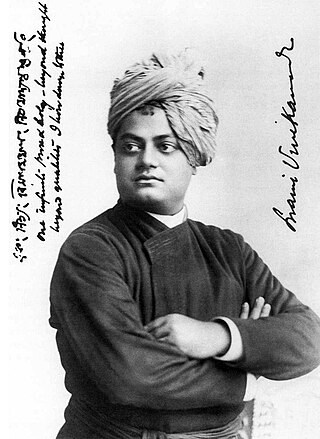
Vedanta Societies refer to organizations, groups, or societies formed for the study, practice, and propagation of Vedanta, the culmination of Vedas. More specifically, they "comprise the American arm of the Indian Ramakrishna movement", and refer to branches of the Ramakrishna Order located outside India.
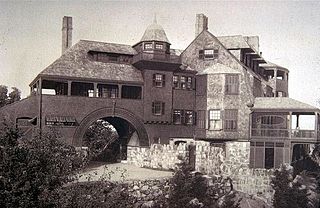
The shingle style is an American architectural style made popular by the rise of the New England school of architecture, which eschewed the highly ornamented patterns of the Eastlake style in Queen Anne architecture. In the shingle style, English influence was combined with the renewed interest in Colonial American architecture which followed the 1876 celebration of the Centennial. The plain, shingled surfaces of colonial buildings were adopted, and their massing emulated.

Wesleyan Grove is a 34-acre (14 ha) National Historic Landmark District in Oak Bluffs, Massachusetts on the island of Martha's Vineyard. Named after John Wesley, the founder of the Methodist Church. Also known as the Martha's Vineyard Campmeeting Association (MVCMA) or the Campgrounds, it was the first summer religious camp established in the United States. It is famous for its approximately 300 colourful cottages in a style now described as Carpenter Gothic.
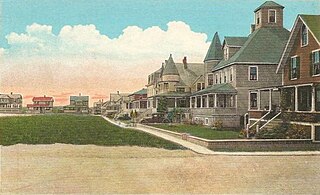
Ocean Park is a village in the town of Old Orchard Beach in York County, Maine, United States. A historic family style summer community affiliated with the Free Will Baptists, the community is located in southern Old Orchard Beach on Saco Bay. Ocean Park continues to be a dry community to this day. Rooted in the Chautauqua tradition, it is occasionally referred to as "Chautauqua-by-the-Sea." The ZIP Code for Ocean Park is 04063.

The Ramakrishna Vivekananda Center of New York is a branch of the Ramakrishna Order of India, founded in 1933 by Swami Nikhilananda. After Nikhilananda's death in 1973, the center was headed by Swami Adiswarananda until the latter's death in 2007. Currently, Swami Yuktatmananda heads the center.

Glyndon Historic District is a national historic district in Glyndon, Baltimore County, Maryland, United States. It is a turn-of-the-20th-century community northeast of Reisterstown, Maryland, that began as a summer resort. The district is residential except for a small business district located at the intersection of Butler Road and the Western Maryland Railway tracks. The Emory Grove Campground on the northern boundary is occupied in the summer. A decided architectural homogeneity exists in Glyndon representing vernacular examples of late 19th century styles. They are typically frame, 2+1⁄2-story-high cottages, with one or occasionally 2-story front porches.

Since 1895, Fountain Park has hosted an annual Chatauqua to promote traditional values and religious, social and educational activities. It was added to the National Register of Historic Places on December 7, 2001.
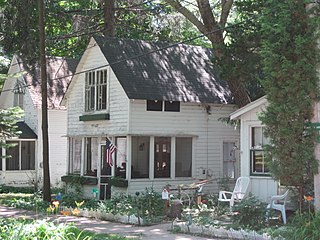
Des Plaines Methodist Camp Ground is a historic Methodist church camp at 1250 Campground Road in Des Plaines, Illinois, USA.

Inspired Talks is a book compiled from a series of lectures of Swami Vivekananda. From mid-June to early August 1895, Vivekananda conducted a series of private lectures to a group of selected disciples at Thousand Island Park. A number of lectures were recorded by Sara Ellen Waldo and she then published those as a book.

The Song of the Sannyasin is a poem of thirteen stanzas written by Swami Vivekananda. Vivekananda composed the poem in July 1895 when he was delivering a series of lectures to a groups of selected disciples at the Thousand Island Park, New York. In the poem he defined the ideals of Sannyasa or monastic life.

Alberta Montagu, Countess of Sandwich was an American heiress, diarist, and letter writer who was the wife of George Montagu, 9th Earl of Sandwich. Like many Gilded Age debutantes from the United States, she married into the British aristocracy and took on the running of her husband's family's ancestral seat, Hinchingbrooke House. Lady Sandwich was a close friend of Mildred Barnes Bliss and was an accomplished musician, writer, and linguist. She was a friend and devotee of the Hindu monk and philosopher Swami Vivekananda, whom she had met in her childhood when he stayed at her family's New York estate. Lady Sandwich hosted Vivekananda in Chicago, New York, and Paris, accompanied him on a trip to Rome, and corresponded with him throughout her life.
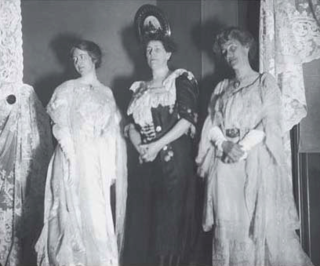
Elizabeth MacLeod Sturges Leggett, also known as Bessie Leggett or Betty Leggett, was an American socialite, letter writer, and disciple of the Hindu monk and philosopher Swami Vivekananda.

























